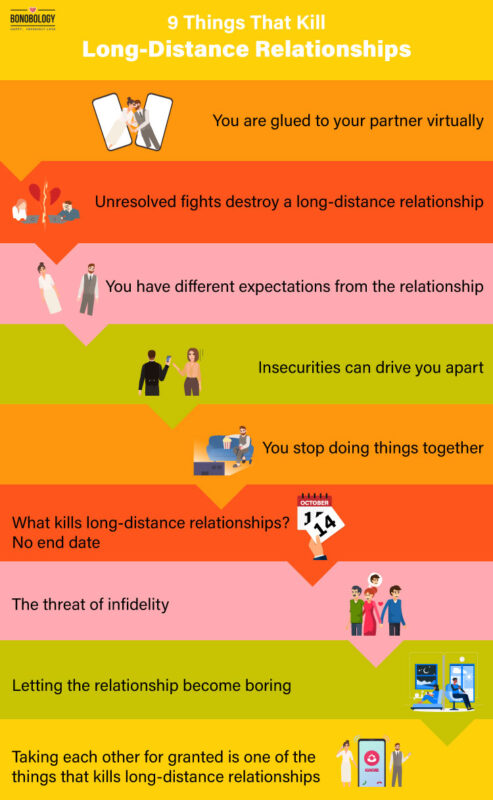What Kills Long-Distance Relationships: Top 5 Pitfalls

Lack of communication and physical intimacy are the two main factors that can kill long-distance relationships. Maintaining a strong connection and emotional security can also be challenging due to the distance and time apart.
Infidelity, lack of effort, ambiguity about the future, and inability to spend quality time together are other factors that can lead to the demise of a long-distance relationship. However, with effort, trust, and open communication, long-distance relationships can survive and even thrive.
We will explore the common challenges that long-distance couples face and provide tips on how to make long-distance relationships work. We will also discuss when to consider ending a long-distance relationship and the bare minimum requirements for a healthy LDR.
The Impact Of Communication Breakdown
The Misinterpretation Of Texts And Tones
When texts and tones are misinterpreted, it can lead to misunderstandings and conflicts in long-distance relationships.
Consequences Of Inadequate Communication
- Increased emotional distance
- Lack of clarity in expectations
- Heightened feelings of insecurity
- Risk of mistrust and suspicion
Effective communication is vital for nurturing trust and understanding in long-distance relationships. Misunderstandings due to misinterpreted texts and tones can create unnecessary tension and distance between partners. Inadequate communication can result in emotional disconnect, lack of clarity, and heightened insecurities.
Physical Intimacy: Bridging The Gap
Long-distance relationships often suffer from the absence of physical intimacy, which plays a crucial role in maintaining emotional connection and bonding between partners. The lack of physical touch can lead to feelings of loneliness and disconnect, impacting the overall health of the relationship.
The Role Of Touch In Bonding
Physical touch is a fundamental aspect of human connection and plays a pivotal role in strengthening emotional bonds. It releases oxytocin, also known as the “love hormone,” which fosters feelings of trust and closeness. In long-distance relationships, the absence of physical touch can lead to a decline in these vital emotional connections, potentially straining the relationship.
Alternative Ways To Maintain Intimacy
In the absence of physical proximity, partners in long-distance relationships can explore alternative methods to maintain intimacy and closeness. This can include virtual dates, video calls, and engaging in activities together online. Additionally, sending surprise gifts, handwritten letters, or care packages can help bridge the physical gap and create moments of connection.
Emotional Security In Absence
When it comes to long-distance relationships, emotional security in absence plays a crucial role in determining the success of the bond. Managing emotional needs and cultivating emotional intimacy from afar are pivotal factors that contribute to sustaining the connection despite physical distance.
Managing Emotional Needs
In the absence of physical presence, it’s essential to proactively address and fulfill each other’s emotional needs. This involves regular and meaningful communication, active listening, and being empathetic towards each other’s feelings and experiences. Expressing appreciation and reassurance can go a long way in creating a sense of emotional security.
Cultivating Emotional Intimacy From Afar
Emotional intimacy can be nurtured through shared experiences, whether it’s watching the same movie simultaneously or engaging in virtual activities together. Open and honest communication about fears, insecurities, and aspirations fosters a deeper emotional connection. Expressing vulnerability and being transparent about emotions builds trust and intimacy.

Credit: www.bonobology.com
Infidelity: A Distance-driven Threat
Infidelity is a pervasive threat in long-distance relationships, often exacerbated by the physical distance between partners. The temptation of physical proximity, combined with the lack of regular face-to-face interaction, can create an environment ripe for mistrust and potential infidelity.
The Temptation Of Physical Proximity
In long-distance relationships, the physical absence of a partner can lead to a heightened desire for physical intimacy. This longing for closeness may create vulnerabilities that can tempt individuals to seek comfort and connection outside of the relationship.
Building Trust Across The Miles
Building and maintaining trust in a long-distance relationship is essential for mitigating the risk of infidelity. Open and honest communication, consistent reassurance, and the establishment of mutual boundaries can help foster trust and emotional security despite the physical separation.
Effort Imbalance And Relationship Burnout
Effort imbalance and relationship burnout are common culprits that can lead to the demise of long-distance relationships. When one partner consistently puts in more effort than the other, it can create feelings of resentment and dissatisfaction. Over time, this imbalance can result in relationship burnout, where one or both partners feel emotionally drained and disconnected.
Recognizing Signs Of Disengagement
It’s important to be aware of the signs of disengagement in a long-distance relationship. These may include a lack of enthusiasm or effort in maintaining the relationship, reduced communication frequency, and decreased emotional intimacy. Recognizing these signs early on can help address the issue before it leads to irreparable damage.
Ensuring Mutual Contribution
Both partners must actively contribute to the relationship to maintain a healthy balance of effort. This involves open communication about each other’s needs and expectations, as well as making mutual efforts to bridge the physical distance. Setting goals together and regularly reassessing the level of contribution from both parties can help prevent an effort imbalance.

Credit: www.bonobology.com
Uncertainty About The Relationship’s Future
Long-distance relationships can be challenging, particularly when uncertainty about the relationship’s future creeps in. The inability to predict the trajectory of the relationship can sow seeds of doubt and anxiety, often leading to its demise.
Handling The ‘what Ifs’
Addressing the ‘what ifs’ in a long-distance relationship is crucial for managing uncertainty. Open and honest communication about potential scenarios can help alleviate fears and provide a sense of security.
Setting Long-term Relationship Goals
Establishing long-term goals as a couple can offer a sense of direction and purpose, mitigating uncertainties about the future. By setting milestones and envisioning the future together, partners can strengthen their bond and commitment.
Quality Time: Making It Count
Maintaining a long-distance relationship can be challenging, and lack of quality time together is one of the main culprits. Communication challenges, infidelity, and ambiguity about the future are other factors that can kill a long-distance relationship. It’s important to focus on building trust, establishing a routine for communication, and embracing the challenges together to make it work.
Creative Solutions For Virtual Dates
Long-distance relationships can thrive with a bit of creativity and effort. Virtual dates offer a wonderful opportunity for couples to spend quality time together, despite the physical distance. Whether it’s cooking the same meal while on a video call, watching a movie simultaneously, or playing online games together, these activities can help create a sense of togetherness and intimacy.
Prioritizing The Relationship
When it comes to maintaining a long-distance relationship, prioritizing the relationship is crucial. This involves setting aside dedicated time for each other, communicating openly and honestly, and actively participating in each other’s lives. Making the effort to stay connected and engaged despite the distance can significantly contribute to the strength and longevity of the relationship.

Credit: jennynurick.com
When Distance Leads To Drifting Apart
Distance can lead to drifting apart in long-distance relationships due to various factors such as lack of physical intimacy, communication challenges, infidelity, and ambiguity about the future. To make it work, couples need to focus on building trust, quality communication, and embracing the challenges together while not sacrificing their own needs.
Signs Of Emotional Drift
Emotional drift in long-distance relationships often manifests through decreased communication, lack of interest in each other’s lives, and growing emotional distance.
Strategies To Rekindle Connection
To bridge the emotional gap, prioritize quality communication, plan virtual date nights, surprise each other with thoughtful gestures, and revisit shared memories to reignite the spark.
Deciding When To Close The Gap
Navigating the decision to close the gap in a long-distance relationship is crucial to identify what can potentially lead to its demise. Factors such as lack of communication, emotional disconnect, and trust issues are common culprits that can kill the bond between partners.
It’s essential to address these issues proactively to sustain a healthy and enduring relationship.
Assessing The Right Time To Reunite
Deciding when to close the gap in a long-distance relationship is crucial. It requires thoughtful consideration to ensure both partners are ready for the next step.
Factors like stability in career and personal life, financial readiness, and emotional preparedness play a significant role in determining the ideal time to reunite.
The Logistics Of Ending Long-distance
Transitioning from a long-distance setup to a shared location involves practical considerations. It’s essential to address logistical aspects such as housing arrangements, job prospects, and potential lifestyle changes.
Effective planning and open communication are key to navigating the logistical challenges of ending the distance and starting a new chapter together.
Long-distance Relationship Survival Tips
Long-distance relationships can be challenging, but with the right strategies, they can thrive. Here are some essential tips to help you navigate the distance and keep your bond strong.
Maintaining Individual Growth
Encourage personal development by pursuing hobbies and interests outside the relationship.
Prioritize self-care to maintain a healthy mindset and emotional well-being.
Leveraging Technology For Closeness
Utilize video calls to create face-to-face interactions despite the physical distance.
Share virtual experiences such as watching movies or cooking together online.
Frequently Asked Questions
When To Give Up On A Long-distance Relationship?
Consider ending a long-distance relationship if communication, trust, and intimacy are consistently lacking.
How Long Can A Long-distance Relationship Last?
Long-distance relationships can last for varying durations, from a few months to several years. Effort from both partners is key for a healthy and enduring relationship.
What Is The Biggest Problem In Long-distance Relationships?
The biggest problem in long-distance relationships is broken communication. It’s the driving force in all relationships, and in long-distance partnerships, it’s the biggest hurdle. Texts and voice tone during calls can be misinterpreted, leading to emotional triggers.
What Is The Bare Minimum In A Long-distance Relationship?
Regular and open communication, along with building trust, are the bare minimum in a long-distance relationship. These form the foundation for a healthy and enduring LDR.
Conclusion
Nurturing trust, open communication, and efforts to bridge the physical gap are crucial. Avoiding lack of communication, trust issues, and emotional disconnect can help sustain long-distance relationships successfully. Remember, consistent effort and understanding are key to overcoming challenges in LDRs.



